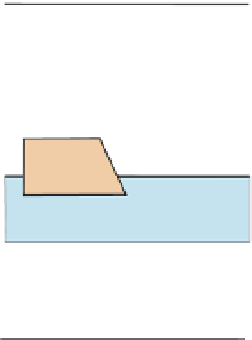Geology Reference
In-Depth Information
Fault systems
Extensional fault systems
Sets of normal faults such as those
shown in Figure 5.4 are typical of
regions where the Earth's crust is being
extended and thinned. Such regions
occur, for example, at
constructive
plate boundaries
- that is, along the
ocean ridges
and
continental rift
systems. Extensional fault systems also
occur locally in mountain belts due
to lateral spreading of the thickened
crust - a process known as gravita-
tional collapse (
see
Chapter 10).
Normal faults are typically arranged
such that uplifted and depressed
blocks are bounded by sets of parallel
or sub-parallel steeply dipping faults,
inclined away from the uplifted blocks
(known as
horsts
) and towards the
depressed blocks (
graben
) as in Figure
5.4A. However, only a limited amount
of extension can be achieved by this
arrangement, and for further exten-
sion to take place, the faults need to be
rotated into a more gently inclined atti-
tude, as seen in Figure 5.4C. This has the
result of also rotating the fault-bounded
blocks, so that originally horizontal
strata within the blocks also become
inclined.
which in turn reduces the weight of
that particular section of the crust. To
maintain gravitational equilibrium, it
is necessary for the underlying mantle
material to rise so that the total weight
of that section remains the same. Thus
in Figure 5.4C, the mantle material
beneath the detachment fault has
bulged upwards to balance the effect
of the thinned crustal material. The
same process occurs in large normal
faults, as shown in Figure 5.4B. Here,
the gravitational response of the exten-
sional crustal thinning is to produce
an
antiformal fold
in the hangingwall
(often termed a '
rollover
') and a
syn-
formal fold
in the footwall. In this
way, the gravitational imbalance that
Gravitational effects of large
extensional faults
Large extensional displacements
of the crust result in local thinning,
Figure 5.4
A.
Extension on a set of steeply-
dipping normal faults creates down-faulted
blocks (termed graben) and up-faulted
blocks (termed horsts); the orange layer has
been extended by a relatively small amount,
equivalent to the cumulative heave on the
normal faults.
B.
The gravitational effect
of a large normal fault can be visualised
by considering the effect of a wooden
block floating in a tank of water (1); once
faulted (2), the block is unstable and must
tilt (3) to maintain equilibrium; (4) the tilted
sections of the block are represented in
nature by a hangingwall antiform (rollover)
and a footwall synform.
C.
Cross-section
through the crust showing how larger
amounts of extension cause initially planar
faults to become curved and rotate due
to solid-state flow in the lower crust. This
process results in extension and thinning
of the upper crust, leading ultimately to
arching up of the lower-crustal material (see
text for further explanation).
D.
Cartoon
sections (after Reston, 2007) showing how
the crust may be stretched and thinned to
form an oceanic basin by the development
of a low-angle normal fault that acts as a
detachment horizon; 1, as the hangingwall
moves to the left, the footwall rises to retain
gravitational equilibrium; 2, the mantle,
roofed by the detachment, is now at the
surface; successor normal faults now cut
through the footwall into the lower crust,
which is now brittle.
graben
horst
A
1
uplift
detachment
zone of flow
C
2
detachment fault
upper crust
lower crust
mantle
1
3
D
footwall
synform
successor faults
hangingwall
antiform
2
B
4




































































Search WWH ::

Custom Search